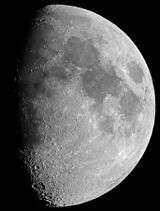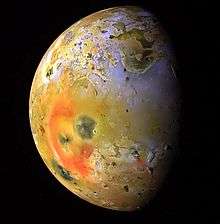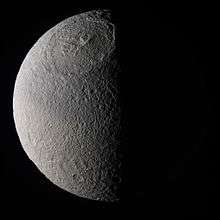List of former planets
This is a list of astronomical objects formerly widely considered planets. As of 2016, there are 8 official planets of the Solar System, and many more exoplanets. Several objects formerly considered exoplanets have been found to actually be stars or brown dwarfs. As the philosophy of what is a planet has evolved, the de facto and dejure definitions of planet have changed over the millennia.
Background
Throughout antiquity, there have been many Classical Planets, once "wandering stars", not all of which are now considered planets. With the advent of the telescope, the moons initially discovered around Jupiter and Saturn, were also considered planets by some. The development of more powerful telescopes resulted in the discovery of the asteroids, the first many of which were initially considered planets. Then Pluto was discovered, the first Trans-Neptunian Object. When electronic imaging came about, Trans-Neptunian Objects of the Kuiper Belt were found, and then Eris, widely hailed as the "new planet", was discovered, which prompted the 2006 round of recategorization of what is a planet.
List
| Former planet | Discovery | Removal | Restored [NB 1] | Current status | Notes | |||
|---|---|---|---|---|---|---|---|---|
 |
The Morning Star | Antiquity | Antiquity | N/A [NB 2] | Aspects of Venus | "Phosphorus", the Morning Star of Greek antiquity (Eosphorus, the Dawn-Bringer; called "Lucifer" by the Romans), and "Hesperus", the Evening Star (called "Vesper" by the Romans), were later identified as a single planet, Venus (Aphrodite). | ||
 |
The Evening Star | Antiquity | Antiquity | N/A [NB 2] | Aspects of Venus | |||
 |
Sun | Antiquity | 1700s | — | Star |  |
Following the acceptance of the Copernican model, the Sun was recognized as not being a planet, as it was the center, and did not orbit the center. | |
 |
Moon | Antiquity | 1700s | — | Moon of Earth |  |
Following the acceptance of the Copernican model, the Moon was recognized as not being a planet, as it orbited the Earth, and did not orbit the center, the Sun. | |
| Io | 1610 | 1700s | — | Moon of Jupiter |  |
Originally presented as satellite planets orbiting the planet Jupiter. Planetary status later rescinded, leaving them only as satellites. | ||
| Europa | 1610 | 1700s | — | Moon of Jupiter | .jpg) | |||
| Ganymede | 1610 | 1700s | — | Moon of Jupiter | .jpg) | |||
| Callisto | 1610 | 1700s | — | Moon of Jupiter | .jpg) | |||
| Titan | 1656 | 1700s | — | Moon of Saturn |  |
Originally presented as satellite planets orbiting the planet Saturn. Planetary status later rescinded, leaving them only as satellites. | [10][4][5] | |
| Iapetus | 1671 | 1700s | — | Moon of Saturn | ||||
| Rhea | 1672 | 1700s | — | Moon of Saturn | _from_Voyager_1.jpg) | |||
| Tethys | 1684 | 1700s | — | Moon of Saturn |  |
|||
| Dione | 1684 | 1700s | — | Moon of Saturn | .jpg) | |||
| Titania | 1787 | — | Moon of Uranus | Originally presented as satellite planets orbiting the planet Uranus. Planetary status later rescinded, leaving them only as satellites. | ||||
| Oberon | 1787 | — | Moon of Uranus | |||||
 |
Ceres | 1801 | 1860s | — | Asteroid and dwarf planet | The first hundred or so asteroids to be discovered were accepted as planets in the Copernican system, as they directly orbited the Sun. With the discovery of many more asteroids, and due to the recognition that unlike the traditional planets they had overlapping orbits, they came to be considered 'minor planets' or 'asteroids' instead, though that process would take longest for the first four to be discovered (Ceres, Pallas, Juno, Vesta). | ||
 |
Pallas | 1802 | 1860s | — | Asteroid | |||
.svg.png) |
Juno | 1804 | 1860s | — | Asteroid | |||
.svg.png) |
Vesta | 1807 | 1860s | — | Asteroid | |||
  |
Pluto | 1930 | 2006 | — | Dwarf planet |  |
Following the discovery of Eris, the International Astronomical Union met to hammer out a definition of planet, as Eris being larger than Pluto, pressured the IAU into making a formal statement on the matter. Either there were to be many planets, or the decision made at the time the asteroids were removed would be repeated. Pluto and Eris, and similar bodies were lumped together like the asteroids before them, and removed, being as representatives of a large group of smaller objects. Pluto would be listed as a "dwarf planet" from the reshuffle. | |
 |
Chiron | 1977 | 1980 | — | Centaur | The discovery of Chiron was hailed by the press and astrologers as that of a new planet. Astronomically, it was different from other objects, asteroids and comets, known at the time, and was classified independently uniquely at that time. Later, it was called an asteroid and then exhibited characteristics of a comet, leading to multiple classifications. Later it was placed into its own category of Centaurs. | ||
 |
Charon | 1978 | 2006 | — | Moon of Pluto |  |
When discovered, Charon, the moon of Pluto, was found to be very large, leading to the declaration by many that the Pluto-Charon system was a double planet (binary planet). The 2006 IAU redefinition of planet removed the possibility of double planets being within the definition. | |
 |
Eris | 2005 | 2006 | — | Dwarf planet |  |
The discovery of Eris, hailed worldwide by the press as the 10th planet, prompted the International Astronomical Union to meet to hammer out a definition of planet. Its discovery pointed to a future of many more similar discoveries, forming an analogue to the time when asteroids were first discovered. In a similar fashion, all such objects were again lumped together, out of the planet club. Eris would be listed as a "dwarf planet" from the reshuffle. | |
Notes
References
- ↑ Leonard Linsky (October 1959). "Hesperus and Phosphorus". The Philosophical Review. 68 (4): 515–518. doi:10.2307/2182495.
- ↑ "The Great Cosmic Light Called Hesperus, Brother Of Lucifer, Reaches Greatest Brilliancy". Star Gazer. Episode 09-07 (1628). February 2009.
- 1 2 Elizabeth Howell (23 December 2015). "What Is The Difference Between the Geocentric and Heliocentric Models of the Solar System?". Universe Today.
- 1 2 3 4 5 6 Holli Riebeek (7 July 2009). "Planetary Motion: The History of an Idea That Launched the Scientific Revolution". The Science: Orbital Mechanics. NASA Earth Observatory.
- 1 2 3 4 5 6 Eric G. Blackman (2006). "The Copernican Model: A Sun-Centered Solar System". Astronomy 104 -- The Solar System. University of Rochester, School of Arts and Sciences, Department of Physics and Astronomy.
- ↑ (in Latin) Galileo Galilei (1610). "Sidereus Nuncius".
- ↑ Al Van Helden (1995). "Satellites of Jupiter". The Galileo Project. Rice University.
- ↑ Calvin J. Hamilton (2009). "The Discovery of the Galilean Satellites". Views of the Solar System.
- 1 2 3 Jean-Pierre Luminet (31 December 2016). "Montaigne, Peiresc, Gassendi, and Cassini - The Provençal Humanists and Copernicus". Inference: International Review of Science. 2 (4).
- ↑ (in Latin) Cristiani Hugenii (Christiaan Huygens) (1659). "Systema Saturnium".
- ↑ (in French) Jean-Dominique Cassini (Giovanni Domenico Cassini) (1673). "Découverte de deux nouvelles planètes autour de Saturne". Paris Observatory.
- ↑ Jean-Dominique Cassini (Giovanni Domenico Cassini) (1686–1692). "An Extract of the Journal Des Scavans. Of April 22 st. N. 1686. Giving an Account of Two New Satellites of Saturn, Discovered Lately by Mr. Cassini at the Royal Observatory at Paris". Philosophical Transactions of the Royal Society of London. 16 (179–191): 79–85. doi:10.1098/rstl.1686.0013. JSTOR 101844.
- ↑ James L. Hilton (18 April 2016). "When did the asteroids become minor planets?". Astronomical Applications Department. U.S. Naval Observatory. Archived from the original on 24 March 2008.
- 1 2 Robert Roy Britt (24 August 2006). "Pluto Demoted: No Longer a Planet in Highly Controversial Definition". SPACE.com.
- 1 2 3 Mike Wall (19 November 2010). "The Man Who Killed Pluto: Q & A with Astronomer Mike Brown". SPACE.com.
- ↑ Hodgson, Richard G. (March 1978). "The Discovery of Chiron: Some Reflections". The Minor Planet Bulletin. IAU MPC. 5 (3): 21–22. Bibcode:1978MPBu....5...21H.
- ↑ "Chiron and the Centaurs". Emerald Visions. Mystic Visions Spiritual Astrology. 2004.
- ↑ Barbara Hand Clow (1987). Chiron: Rainbow Bridge Between the Inner and Outer Planets. Llewellyn. ISBN 087542094X.
- ↑ Richard Nolle (1983). Chiron: The New Planet in Your Horoscope, The Key to Your Quest. American Federation of Astrologers. ISBN 0866902368.
- ↑ "In Greenwich". Popular Mechanics. Vol. 158 no. 1. January 1982. p. 28.
- ↑ E. Mostra (1998). "Pluto and Charon". Voyage in the Universe. Astronomical Observatory of Padua.
- ↑ David Whitehouse (30 July 2005). "Astronomers detect '10th planet'". BBC News.